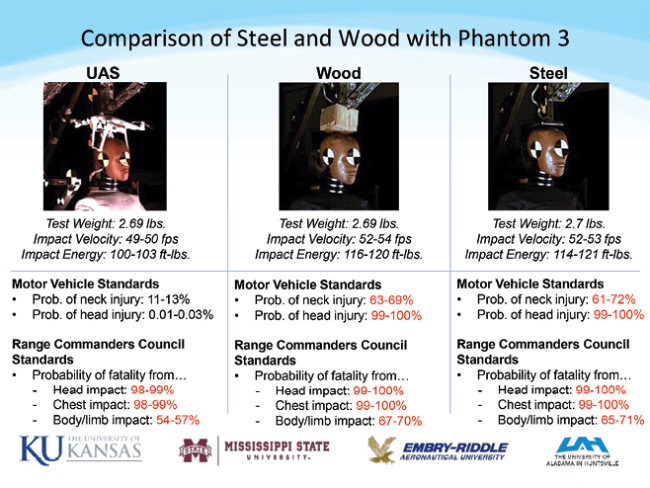
A Big Oops |
At first blush, the Federal Aviation Administration (FAA) notice of proposed rulemaking for small UAS operations over people seemed quite positive. But the weights chosen as impact limits are off by a factor of ten. Unless adjusted, the real impact of these restrictions will be to severely limit the U.S. commercial UAS industry.
How the FAA can realign its ops over people approach:
- Use realistic impact numbers.
- Bridge the disconnect between research and rules.
- Recognize that assumed risk is part of any vehicle system.
I initially thought the recent FAA notice of proposed rulemaking (NPRM) for operations of small unmanned aircraft systems (sUAS) over people was a big step ahead. The rule included reasonable night operations, a solid methodology for weighing risks, three reasonable categories to allow operations over people and even a means to assess compliance with standards for such ops. The only downsides I saw were that the weight category for “category one” operations over people (sUAS too small to cause injuries) was way too light and there was a prohibition against operating sUAS over moving vehicles. Hence, I put out an upbeat assessment to the rules via my email list.
Then the engineers started calling. By the time I finished my third phone call, I was convinced the FAA had an oops in their proposed ops over people rule.
THE PROBLEM WITH PROHIBITION
The problem is the numbers. I should have known there were problems when the FAA admitted ASSURE’s (Alliance for System Safety of UAS through Research Excellence) ground impact research showed that even a 2,000-gram sUAS could fly over people and then proceeded to select 250 grams as the category one limit. It seems this started a pattern; the impact numbers used to assess category two ops over people (sUAS that have a low probability of causing a casualty) and category three (sUAS that have a low probability of causing a fatality) were also off by a factor of ten and will have a substantial impact on the number of vehicles approved for such operations with reasonable flight envelopes to perform a useful purpose.
I don’t know how the FAA ended up with impact numbers that disagreed with the initial phase of ASSURE’s sUAS ground impact research, but I have a theory.
It’s well worth reading the ASSURE phase one sUAS ground impact report here: www.assureuas.org/projects/deliverables/sUASGroundCollisionReport.php The 195-page report covered a number of ground collision subjects, but the portion most relative to the FAA’s ops over people impact numbers are ASSURE’s test of DJI Phantom 3’s against anthropomorphic test dummies (ATD) using automotive impact standards and the discussion of a rather obscure Department of Defense (DOD) standard—the Range Commander’s Council (RCC) standard 321-00.
As part of their sUAS ground impact research, ASSURE researched hundreds of publications, regulations, standards and rules looking for existing guidance assessing risk to people on the ground from falling objects. The most applicable standard was RCC 321-00, a DOD standard created for the DOD national test ranges to help commanders assess risk from falling test objects, such as small bolts ejected during weapons tests, debris from failed missile tests or aircraft collisions. RCC 321-00 was a decent starting point but ASSURE soon found out RCC 321-00 wasn’t applicable to sUAS ground collisions.
RCC 321-00 assumed every object was a dense metal object falling from high altitude. Hence, the only variables were weight and velocity. However, sUAS ground collisions never occur due to an inflight breakup at high altitudes as manned aircraft do, resulting in a large quantity of small metal fragments individually hitting people on the ground. sUAS collide at lower speeds and the whole platform strikes an individual body. Hence, sUAS have a larger contact area in a collision and different crash geometries than debris.
Furthermore, because sUAS aren’t made completely of metal, they are elastic during a collision, causing sUAS collisions to be dramatically different than solid debris fragments collisions. Contact area matters—which would you rather have fall on you: a one-pound pillow or the edge of a one-pound straight razor? Energy absorbing design also matters—would you rather run in to a 1950s Chevrolet with old fashioned bumpers or a modern Chevy with bumpers that crumple on impact?
What’s worse, the RCC standard assumed this solid object was hitting another solid object—not a human being that could absorb a lot of impact energy. Think of it as a baseball hitting a wooden baseball bat vs. a baseball hitting a foam rubber bat. Which one would transfer more energy and hit the ball further?
THE AUTOMOTIVE ANALOGY
ASSURE researchers felt the automotive industry had the best methodology to assess impact damage, even though this methodology dealt only with collisions on the ground versus collisions in the air. The automotive impact standards in Federal Motor Vehicle Safety Standard (FMVSS) 208 may not have assessed sUAS impacts with humans, but its methodology was based on hundreds of thousands of data points on a variety of objects striking human beings. Indeed, ASSURE researchers found a major difference between injuries predicted by the RCC standards and the FMVSS standards even when using the same solid objects striking at the same velocity. There was a great difference when researchers used actual sUAS versus solid objects for impact studies using the RCC and FMVSS standards.
The accompanying slide from the official FAA briefing www.assureuas.org/projects/deliverables/a4/FAA-ASSURE_Ground_Collision_Research.pdf shows the differences best.

The box on the right of the slide shows differences between the FMVSS and RCC standards against a steel ball (the default object used by RCC), whereas the box on the left shows impact of an actual DJI Phantom 3. Note how the FMVSS standards consistently show injury versus fatality compared to RCC and how the Phantom’s energy absorbing airframe causes only a 0.01-0.03% probability of head injury versus a 99-100% probability caused by the same weight of steel moving at the same velocity. Automotive metrics are developed to assess injury risk whereas the RCC standard is only established to assess fatality based on impacts.
Unfortunately, the FAA appears to have used the RCC standards for their operations over people rule, resulting in an extremely conservative energy transfer of 11 foot pounds of kinetic energy from a rigid object for category 2 ops over people and 25 foot pounds for category 3 standards. A DJI Phantom 3 falling under a parachute probably wouldn’t meet either of these standards. Why would they do that?
The same reason the FAA stuck with 250 grams as the weight standard for category one ops over people when ASSURE research showed 2,000 grams was the answer: there was an existing, similar aviation rule. Two hundred fifty grams has long been the FAA minimum sUAS weight because there was an existing European rule that set that weight as the minimum for sUAS. Hence, 250 grams is the minimum for registering your sUAS and it became the category one ops over people weight. Unfortunately, the FAA used the RCC standards as the basis for its rules on debris falling from commercial space launches and I’ll wager the FAA got its extremely low impact numbers from this existing rule. Hence, the disconnect between research and rules.
HOPEFUL METHODOLOGY
This isn’t to say all is lost. The FAA set up a very solid, research-based methodology to assess risk to ops over people; it just needs to wait for the second phase of ASSURE research and plug in the correct numbers. ASSURE delivers its much more extensive phase two ground collision research to the FAA in early February. It will undergo a month of peer review and be released to the public shortly thereafter. ASSURE’s phase one research only assessed one sUAS type using a single impact methodology. Phase two will decide which is the best standard for sUAS collisions—the RCC standard used in this NPRM, the FMVSS or something else. This will be determined by crashing 14 different types of sUAS hundreds of times against a variety of realistic targets, including post-mortem human surrogates (cadavers). All told, it’s about $2.2 million in research and the public should have the right to assess it before commenting on this NPRM.
What happens if research doesn’t guide FAA rulemaking? Very, very few sUAS over 250 grams, even with energy absorbing airframes or parachutes that can impact at either 11 or 25 ft lbs of kinetic energy transferred from a rigid object. Researchers aren’t sure even the 620-gram, frangible Advantage Robotics Snap sUAS already approved for ops over people can meet this standard. We’ll never have drone operations in urban areas with the rule in its present form.
The impact standard numbers can be fixed; however, the prohibition against sUAS operations over moving vehicles can’t. The FAA prohibition on ops over moving vehicles is a real head-scratcher. I was on the ops over people aviation rulemaking committee (ARC) and we never discussed it. We discussed the opposite; that it would be safer to fly over roads because everyone would be protected inside automobiles. The moving vehicle prohibition drew a “wait…what?” response from my engineer buddies also. They agreed that steel roofs and shatter-resistant windshields were great protection from errant drones.
The only reason I can think of for a moving vehicle prohibition is someone late in the review process inserted it thinking a falling drone would cause a driver to swerve and crash. If so, that is NOT a reason to block drone flights over moving vehicles. Having an object crash through one’s windshield while driving is just one of those assumed risks we all take on the road. If the object is a brick, a deer or a drone, drivers assume the risk and are (hopefully) trained not to over-react to something hitting their car. Our family has been hit by rocks, steel rods, a really big bat, a pheasant and a water moccasin (long story), but we still drive. And we wouldn’t blame the FAA if it let drones add to this collision risk.
If the FAA insists on worrying about drone impacts with moving vehicles, it should get ASSURE to research standards for sUAS windshield penetration against vehicles moving at realistic highway speeds. If the sUAS can penetrate a car windshield and cause either category 2 or 3 injuries against the occupants, the sUAS should be allowed to fly over moving vehicles. Simple impact with a windshield shouldn’t be the standard. If the FAA is worried about windshield impacts, it should simply stipulate that all sUAS cross roads at a 90-degree angle to minimize the combined impact speed with other vehicles. Many waivers have been approved for beyond visual line of sight (BVLOS) using this approach and it minimizes risk.
ACTING AGAINST PROHIBITION
But if the FAA keeps a prohibition on flight over moving vehicles, it will make the commercial drone industry non-viable. What BVLOS operation can be conducted without crossing any roads with vehicles on them? Can you imagine delivering packages without flying over moving vehicles somewhere along the route? Doing an insurance claim survey after a disaster without flying over roads? A ban on loitering over Interstates could possibly be appropriate, but not a prohibition of flying over moving vehicles at any time. By the way, if you are flying over the moving vehicle, then you are unlikely to hit it because it will be gone by the time you descend to strike it. Air Force pilots spend years learning to hit moving vehicles from aircraft and still mess it up. The provision is a non-starter.
The really good news is the FAA will take comments from the public when it publishes these rules on the Federal Register. Here’s what I suggest we all write:
“The kinetic energy transfer figures in § 107.115 Category 2 operations (b) (1) (i) and § 107.120 Category 3 operations (b) (1) (i) are extremely conservative and will cripple the commercial UAS industry if adopted. The FAA should wait for the public release of the Task A14 Ground Collision Severity Study to allow the public and manufacturers to review the findings and make a public comment on the draft NPRM before proceeding. Valuable data will be available shortly that could guide the FAA and the public in addressing meaningful comments to the draft NPRM.
“The FAA should remove § 107.105 Prohibition on operations over moving vehicles. No small UAS qualified for operations over people in category one, two and three would cause injury from collisions to occupants in moving vehicles. The FAA should not consider ground vehicle driver reaction to a small UAS collision. Collision with flying objects is a well-known driving hazard that all licenced drivers should be trained to encounter. Failure to remove § 107.105 will make the commercial UAS industry non-viable in this country. It is difficult to envision commercial UAS tasks that do not involve flying over moving vehicles in some manner.”
This is a big one folks, but the FAA can fix its oops. If it goes out as is, we won’t have a commercial UAS industry in this country.






